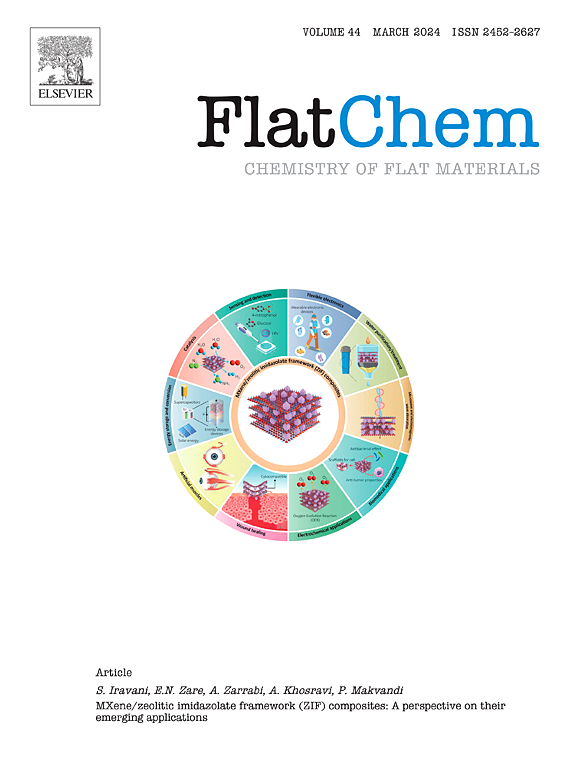Lateral growth of WSe2 monolayer film in a confined reaction environment via an Au vapor-assisted CVD: A systematic and comparative study with a NaCl-assisted CVD
IF 6.2
3区 材料科学
Q2 CHEMISTRY, PHYSICAL
引用次数: 0
Abstract
Two-dimensional (2D) monolayer tungsten diselenide (WSe2) is of great interest in optoelectronic and photo(electro)catalytic applications due to its direct optical band gap characteristic which is highly dependent on the number of layers. Achieving uniform, high-purity, large-area monolayer WSe2 with the traditional salt-assisted chemical vapor deposition method (CVD) remains challenging due to the issues controlling the growth mechanisms and number of layers. Recent studies have demonstrated that metal vapor-assisted CVD can achieve uniform development of large-scale WSe2 monolayers. It is critical to comprehensively examine the influence of metal vapor-assisted CVD parameters on lateral WSe2 growth relative to salt-assisted CVD and to analyze the underlying mechanisms. Here, we carried out a systematic and comparable study assessing the effect of several CVD parameters on lateral WSe2 monolayer growth in the presence of a NaCl and an Au vapor catalyst, respectively. Detailed characterization of the grown WSe2 materials confirmed that using only a gold vapor catalyst in a confined micro-reactor space of sapphires allows for the ultrafast growth of highly crystalline, uniform, and sub-centimeter-sized monolayer WSe2 films without any residual ions, which can be scalable for reliable high-performance device fabrication and photocatalytic applications. Moreover, we observed that in-situ etching could occur on the film by the increased reaction time. Overall, this study paves the way for future research on fabricating large-area monolayer transition metal dichalcogenides and reaction mechanisms using gold or other metal vapor-assisted CVD in a confined reaction environment.

通过Au气相辅助CVD在受限反应环境中横向生长WSe2单层膜:与nacl辅助CVD的系统和比较研究
二维(2D)单层二硒化钨(WSe2)由于其直接光学带隙特性高度依赖于层数而在光电和光(电)催化应用中引起了极大的兴趣。利用传统的盐辅助化学气相沉积法(CVD)获得均匀、高纯度、大面积的单层WSe2仍然具有挑战性,因为存在控制生长机制和层数的问题。近年来的研究表明,金属气相辅助气相沉积可以实现大规模WSe2单层膜的均匀发育。相对于盐辅助CVD,综合研究金属气相辅助CVD参数对WSe2横向生长的影响并分析其潜在机制至关重要。在这里,我们进行了一项系统的和可比较的研究,分别评估了在NaCl和Au蒸气催化剂存在下,几种CVD参数对WSe2单层横向生长的影响。生长的WSe2材料的详细表征证实,在蓝宝石的密闭微反应器空间中仅使用金蒸汽催化剂,可以超快地生长出高度结晶、均匀、亚厘米大小的单层WSe2膜,没有任何残留离子,这可以扩展到可靠的高性能器件制造和光催化应用。此外,我们还观察到,随着反应时间的延长,薄膜上可以发生原位蚀刻。总的来说,本研究为未来在有限反应环境下利用金或其他金属气相辅助CVD制备大面积单层过渡金属二硫化物和反应机理的研究铺平了道路。
本文章由计算机程序翻译,如有差异,请以英文原文为准。
求助全文
约1分钟内获得全文
求助全文
来源期刊

FlatChem
Multiple-
CiteScore
8.40
自引率
6.50%
发文量
104
审稿时长
26 days
期刊介绍:
FlatChem - Chemistry of Flat Materials, a new voice in the community, publishes original and significant, cutting-edge research related to the chemistry of graphene and related 2D & layered materials. The overall aim of the journal is to combine the chemistry and applications of these materials, where the submission of communications, full papers, and concepts should contain chemistry in a materials context, which can be both experimental and/or theoretical. In addition to original research articles, FlatChem also offers reviews, minireviews, highlights and perspectives on the future of this research area with the scientific leaders in fields related to Flat Materials. Topics of interest include, but are not limited to, the following: -Design, synthesis, applications and investigation of graphene, graphene related materials and other 2D & layered materials (for example Silicene, Germanene, Phosphorene, MXenes, Boron nitride, Transition metal dichalcogenides) -Characterization of these materials using all forms of spectroscopy and microscopy techniques -Chemical modification or functionalization and dispersion of these materials, as well as interactions with other materials -Exploring the surface chemistry of these materials for applications in: Sensors or detectors in electrochemical/Lab on a Chip devices, Composite materials, Membranes, Environment technology, Catalysis for energy storage and conversion (for example fuel cells, supercapacitors, batteries, hydrogen storage), Biomedical technology (drug delivery, biosensing, bioimaging)
 求助内容:
求助内容: 应助结果提醒方式:
应助结果提醒方式:


